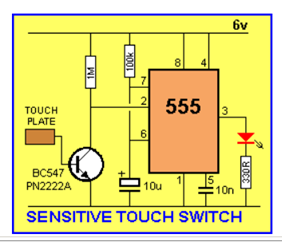I made a touch switch in PCB based in the following schematic
When touching the plate with a finger the BJT turns on and the 555 trigger pin goes LOW activating the pin 3 (OUTPUT). The time the output is on depends of the 100K resistor and the 10u capacitor
Below you can see the schematic and the PCB
Changes in the original circuit
- I’ve used VCC=9v instead of VCC=6V
- To level out any fluctuations in the power supply voltage that might affect the operation of the timer. I’ve added a 10 nF capacitor to pin 5
- Probably because of the noise generated by my power supply the circuit was turning on randomly so I’ve added C3 to prevent this (The value of C3 was discovered by trial and error).
With the changes described above circuit works well with a power supply with 9V.
The issue appears when I change my power supply by a 9V battery.
- When I use a 9V battery the circuit only works well if I’m not isolated from the earth (touching the floor with a bare foot)
- If I’m isolated from the earth (using shoes) the circuit usually stops working after 3 or 4 tries and only works again if I touch the earth.
When I connect the GND of the circuit to the GND of the oscilloscope the circuit works fine (Probably because the GND of the oscilloscope is connected to earth).
How can I improve the circuit to prevent this behavior when using a battery?



